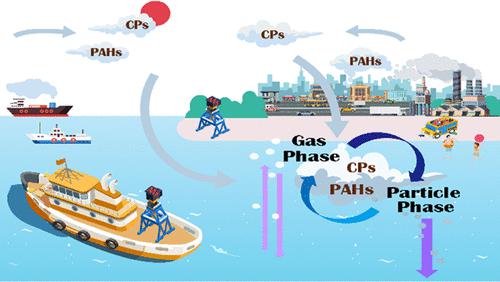当前位置:
X-MOL 学术
›
Environ. Sci. Technol.
›
论文详情
Our official English website, www.x-mol.net, welcomes your
feedback! (Note: you will need to create a separate account there.)
Land–Ocean Exchange Mechanism of Chlorinated Paraffins and Polycyclic Aromatic Hydrocarbons with Diverse Sources in a Coastal Zone Boundary Area, North China: The Role of Regional Atmospheric Transmission
Environmental Science & Technology ( IF 10.8 ) Pub Date : 2022-08-05 , DOI: 10.1021/acs.est.2c00742 Lu Jiang 1, 2 , Xindong Ma 3 , Yawei Wang 1, 4 , Wei Gao 5 , Chunyang Liao 1 , Yunfei Gong 3 , Guibin Jiang 1, 2, 4
Environmental Science & Technology ( IF 10.8 ) Pub Date : 2022-08-05 , DOI: 10.1021/acs.est.2c00742 Lu Jiang 1, 2 , Xindong Ma 3 , Yawei Wang 1, 4 , Wei Gao 5 , Chunyang Liao 1 , Yunfei Gong 3 , Guibin Jiang 1, 2, 4
Affiliation

|
The marine environment is regarded as a crucial “sink” of numerous land-origin pollutants. As typical boundary regions, the coastal and offshore areas are used to evaluate the dominating transfer process and land–ocean exchange mechanism of semivolatile organic compounds. In air samples collected from a coastal area in North China over a whole year, chlorinated paraffins (CPs), including short-chain CPs and medium-chain CPs, and prior control 16 polycyclic aromatic hydrocarbons (PAHs) were determined, with mean concentrations of 25.8 and 94.7 ng/m3, respectively. Results of different gas–particle partitioning models indicated that the steady-state hypothesis provides a better description of the possible land–ocean exchange molecular mechanism. The source–sink influences for CPs and PAHs were affected by the predominant atmospheric motion, which alternated between gaseous diffusion and particulate sedimentation in different seasons. Source apportionment results indicated that different transfer characteristics contributed to the source divergence of ambient CPs and PAHs within 12 nautical miles in the same area. Coal/biomass combustion and diesel/natural gas combustion were the main PAH sources in the coast site (43.1%) and sea site (35.3%), respectively. Similar industrial sources CP-52 and CP-42 were the main CP sources in the coast site (41.4%) and sea site (40.8%), respectively.
中文翻译:

华北海岸带边界地区不同来源氯化石蜡和多环芳烃的海陆交换机制:区域大气传输的作用
海洋环境被认为是众多陆源污染物的重要“汇”。作为典型的边界区域,沿海和近海地区被用来评价半挥发性有机化合物的主导转移过程和陆海交换机制。在华北沿海地区全年采集的空气样品中,测定了氯化石蜡(CPs),包括短链CPs和中链CPs,以及之前对照的16种多环芳烃(PAHs),平均浓度为25.8 和 94.7 ng/m 3, 分别。不同气体-粒子分配模型的结果表明,稳态假设更好地描述了可能的陆-海交换分子机制。CPs 和 PAHs 的源汇影响受主要大气运动的影响,在不同季节,大气运动在气体扩散和颗粒沉降之间交替。源解析结果表明,不同的传递特性导致了同一区域12海里内环境CPs和PAHs的源发散。煤/生物质燃烧和柴油/天然气燃烧分别是沿海站点(43.1%)和海上站点(35.3%)的主要 PAH 来源。类似的工业源 CP-52 和 CP-42 分别是沿海站点(41.4%)和海上站点(40.8%)的主要 CP 源。
更新日期:2022-08-05
中文翻译:

华北海岸带边界地区不同来源氯化石蜡和多环芳烃的海陆交换机制:区域大气传输的作用
海洋环境被认为是众多陆源污染物的重要“汇”。作为典型的边界区域,沿海和近海地区被用来评价半挥发性有机化合物的主导转移过程和陆海交换机制。在华北沿海地区全年采集的空气样品中,测定了氯化石蜡(CPs),包括短链CPs和中链CPs,以及之前对照的16种多环芳烃(PAHs),平均浓度为25.8 和 94.7 ng/m 3, 分别。不同气体-粒子分配模型的结果表明,稳态假设更好地描述了可能的陆-海交换分子机制。CPs 和 PAHs 的源汇影响受主要大气运动的影响,在不同季节,大气运动在气体扩散和颗粒沉降之间交替。源解析结果表明,不同的传递特性导致了同一区域12海里内环境CPs和PAHs的源发散。煤/生物质燃烧和柴油/天然气燃烧分别是沿海站点(43.1%)和海上站点(35.3%)的主要 PAH 来源。类似的工业源 CP-52 和 CP-42 分别是沿海站点(41.4%)和海上站点(40.8%)的主要 CP 源。









































 京公网安备 11010802027423号
京公网安备 11010802027423号